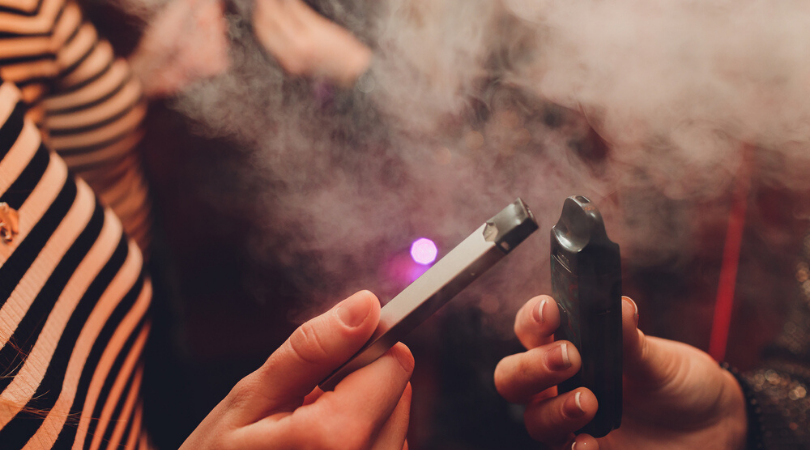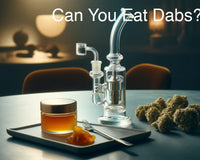
A lot of cannabis users believe that they can only customize their buzz according to the strains available on their shelves. However, the right temperature is an equally significant factor. In fact, it is regarded as the key to unlocking the effects of your cannabis strain.
Think of it this way: If you are looking to reap the benefits of cannabidiol or CBD (a nonintoxicating cannabinoid that could potentially help manage anxiety symptoms), a strain that's rich in it must be heated to the compound's boiling point of 356 degrees Fahrenheit. In the same manner, the effects of linalool (a terpene that could help you relax) will not be unleashed until you reach 388 degrees Fahrenheit.
Temperature control can also determine the intensity of your strain. A higher temp range usually exaggerates the effects of your weed, while a lower temp range typically offers a gentler and mellower experience.
How Vaporization Could Be Better Than Combustion
Let's face it — the kind of customization mentioned above is not possible with conventional smoking. Once you bring a lighter to your bowl, you are combusting the herb, which creates harmful byproducts through the smoke.
For example, the boiling point of tetrahydrocannabinol or THC (the main chemical responsible for getting you high) is 315 degrees Fahrenheit, but active vapors can already start forming nearly a hundred degrees before that. When temperatures hit combustion level (around 455 degrees Fahrenheit), tars and other undesirable compounds, such as carbon monoxide, benzene, and dioxins, are released into the air.
Avoiding these undesirable compounds by vaporizing your weed is just one of the many reasons why some people find vaping to be a better and healthier option than combustion-based smoking.
Understanding Vaporization and Temperature Control
Vaporizing your weed is generally a process where you avoid combustion by heating your herb at a low enough temperature. While vaporization helps you extract the compounds in a controlled manner, combustion burns and releases all of these molecules instantly.
Due to moisture content, every plant's combustion point varies. But as mentioned earlier, combustion generally occurs at 455 degrees Fahrenheit. Temperatures as high as this indeed are enough to activate THC and other compounds. However, this approach is not exactly efficient because heating weed at these high temperatures can also damage certain cannabinoids and terpenes.

Why Is It Important to Get the Right Temperature?
The temperature you vape at considerably affects what you will be inhaling. The cannabis plant contains hundreds of naturally occurring compounds, such as cannabinoids and terpenes, that determine the quality of your weed.
As you may already know, cannabis is made up of hundreds of chemical compounds known as cannabinoids. These can occur in various concentrations depending on the strain you are using. Terpenes, on the other hand, are aromatic oils secreted in the same glands of the cannabis plant that produce cannabinoids. They give cannabis varieties their distinctive colors and flavors.
All cannabinoids and terpenes have varying boiling points. The specific temperatures at which you vape determine which aggregates of these molecules you end up with. This, in turn, shapes the properties of your weed, such as the mind-altering effects and tastes.
Vaping Temperature Chart
Since changes in your vaping temperature can potentially alter the chemical structure of your weed, influencing its effects and taste, here's a list of the average boiling point of the most common cannabinoids and terpenes found in cannabis. Get started with this simple guide to help you achieve your desired effects.
|
Cannabinoid |
Properties and Potential Effects |
Boiling Point |
|
Cannabigerol (CBG) |
Non-psychoactive; may have antibacterial and anti-inflammatory properties |
126 degrees F / 52 degrees C |
|
Cannabichromene (CBC) |
Can potentially relieve pain and inhibit cancer cells; may have anti-inflammatory properties |
220 degrees Fahrenheit / 104 degrees Celsius |
|
Tetrahydrocannabinolic Acid (THCa) |
May have anti-inflammatory, anti-proliferative, and antispasmodic effects |
220 degrees Fahrenheit / 104 degrees Celsius |
|
Cannabidiolic Acid (CBDa) |
Possibly anti-inflammatory |
248 degrees Fahrenheit / 120 degrees Celsius |
|
Tetrahydrocannabinol (THC) |
Most abundant compound and most well-known psychoactive component in cannabis; may have mild analgesic and antioxidant properties |
315 degrees Fahrenheit / 157 degrees Celsius |
|
Cannabidiol (CBD) |
Has tremendous therapeutic promise to manage anxiety and mood disorders, relieve chronic pain and inflammation, and other effects |
356 degrees Fahrenheit / 180 degrees Celsius |
|
Cannabinol (CBN) |
Mildly psychoactive, sedative |
365 degrees Fahrenheit / 185 degrees Celsius |
|
Tetrahydrocannabivarin (THCv) |
Can potentially suppress appetite, reduce panic attacks, and promote bone growth |
428 degrees Fahrenheit / 220 degrees Celsius |

|
Terpene |
Aroma |
Potential Effects |
Boiling Point |
|
A-Pinene (Pn) |
Pine |
May make you alert, retain memory, and possibly counteract some effects of THC |
311 degrees Fahrenheit / 155 degrees Celsius |
|
β-Caryophyllene (Cr) |
Cloves, pepper, spicy, and woody |
Possibly help relieve stress |
320 degrees Fahrenheit / 165 degrees Celsius |
|
β-Myrcene (Mc) |
Cardamom, cloves, musky, earthy, and herbal |
Could be sedating and relaxing |
334 degrees Fahrenheit / 168 degrees Celsius |
|
Limonene (Lm) |
Citrus |
May help elevate mood and relieve stress |
349 degrees Fahrenheit / 176 degrees Celsius |
|
Terpinolene (Te) |
Piney, floral, and herbal |
Could be uplifting |
365 degrees Fahrenheit / 185 degrees Celsius |
|
Linalool (Ln) |
Floral |
May enhance mood and be sedating |
388 degrees Fahrenheit / 198 degrees Celsius |
|
Humulene (Hu) |
Hops, woody, and earthy |
May be an anti-inflammatory |
388 degrees Fahrenheit / 198 degrees Celsius |
|
Phytol |
Floral and balsamic |
Could relieve pain and be an anti-inflammatory |
399 degrees Fahrenheit / 204 degrees Celsius |
|
Citronellol |
Floral, sweet, citrus, and roses |
Potentially anti-inflammatory and tumor-inhibiting |
437 degrees Fahrenheit / 225 degrees Celsius |
|
Caryophyllene oxide |
Dry, fresh, spicy, sweet, and woody |
May have antifungal and anticoagulant properties |
495 degrees Fahrenheit / 257 degrees Celsius |
General Guidelines for Vaping
As mentioned, the purpose of vaporization is to convert the cannabis compounds and essential oils into gas form. This is accomplished by heating your weed to a certain temperature range for an efficient transition from liquid to vapor, instead of burning it.
Cannabis has many different compounds you would want to vaporize, and it is by understanding how varying temperatures affect and release the active compounds in your weed can you control the quality of your vaping experience.
Vape pens, counter-top vaporizers, and other vape gears operate at much lower temperatures compared to your usual open flame. As a rule, setting your vape gear to a temperature lower than 356 degrees Fahrenheit can bring about the best flavor to your weed with mild mind-expanding effects. Meanwhile, temps between 356 and 392 degrees Fahrenheit can give you ample flavor with moderate psychotropic effects. Higher than 392 degrees Fahrenheit, on the other hand, will yield less flavor and more cannabinoids to generate heavy trippy effects.

Lightly Toasted (325 degrees Fahrenheit to 350 degrees Fahrenheit)
As mentioned, low temperatures would be great if you want the best flavor from your weed. This range will give you a fresh taste with citrusy and piney undertones. Besides, the vapor tends to be much cooler and smoother on your throat.
THC, the chemical in cannabis responsible for making you high, has a boiling point of 315 degrees Fahrenheit. Vaping at low temperatures (325 degrees Fahrenheit to 350 degrees Fahrenheit) will potentially result in calming effects with light euphoria. Some users, however, might experience a few side effects, such as dry mouth, red eyes, and lethargy. That being so, lightly toasted weed is generally ideal for new users and those who don't want to get too intoxicated.
Terpenes Extracted: A-Pinene (PnA), β-Caryophyllene (Crβ), β-Myrcene (Mcβ), Limonene (Lm), and citronellol
Cannabinoids Released: Cannabidiolic acid (CBDa), Cannabichromene (CBC), CBD, Cannabigerol (CBG), Tetrahydrocannabinolic acid (THCa), and THC
Half-Baked (350 degrees Fahrenheit to 400 degrees Fahrenheit)
If you are still experimenting, this is also a safe place to start. In a half-baked range, you will still benefit from the effects of terpenes but with more access to cannabinoids than at lower temperatures. Vaping between 350 to 400 degrees Fahrenheit will bring about a thicker and warmer vapor, which can be satisfying for transitioning users. You will also taste a richer flavor since more of the cannabinoids are present.
Since more THC is being volatilized at this range, potential psychoactive effects will be stronger. It can put you in a relaxing, meditative state with a dose of euphoria without feeling lethargic. This temperature range is a great middle ground between flavor and effects.
Terpenes Extracted: Lm, Terpinolene (Te), Linalool (Ln), Humulene (Hu)
Cannabinoids Released: CBDa, CBD, CBC, Cannabinol (CBN), CBG, THCa, THC

Fully Baked (350 degrees Fahrenheit to 430 degrees Fahrenheit)
For those who are looking for the best cannabinoid extraction, this is the temperature range to be in. While the vapor will be a lot hotter and less flavorful, you will benefit from the strongest psychedelic effects from the fully baked temperature. Vaping between 350 to 430 degrees Fahrenheit can induce lethargy, making it suitable for nighttime sessions.
At this range, many terpenes will be instantly depleted, so it's best to reserve this scale toward the end of your sessions when you want to really blast off. Vaping at fully baked temps will be the closest thing you can get to combustion without actually smoking.
Terpenes Extracted: Hu, phytol, and caryophyllene oxide
Cannabinoids Released: CBDa, CBD, CBC, CBG, CBN, THCa, THC, and Tetrahydrocannabivarin (THCv)
What's the Ideal Vaping Temperature?
Deciding on the most reliable temperature is often unclear when it comes to vaping dry herbs. As you may have already noticed, every user's experience varies widely depending on a few factors.
For example, two cannabis vape gears set to similar temps can sometimes yield different kinds of vapor. Keep in mind that every strain of cannabis is made of a wide array of terpenes and cannabinoids, which contribute to its unique aroma, flavor, and psychotropic effects. Considering these organic compounds volatilize at varying temperatures and can alter your experience in many different ways, there is no single best temperature to vape weed. The ideal vaping temperature largely depends on what kind of effects you want.
Nevertheless, if it comes down to choosing just one temperature to vape at, it's probably fitting to go for 410 degrees Fahrenheit. It's high enough to vaporize the pertinent cannabinoids and terpenes but low enough to avoid destroying these compounds in the process.

How to Manage Your Expectations for a Full Vaping Experience
Although vaping could be regarded as a healthier (and maybe even better) way to consume cannabis than conventional smoking, a lot of first-time users end up getting disappointed from the experience. Either their vape gear didn't match their style, they just don't know how to use it properly, or they expected exactly the same outcomes as when they smoked weed.
For these reasons, some users never got the chance to truly appreciate the process and forever turned their backs on vaporizers. You can't totally blame them, though, as everyone only wants a great experience. If you are new to vaping, here are a few tips to help you manage your expectations and reap the benefits of using vaporizers.
- Do Your Research. Not all vape gears offer the luxury of customizing the temperature range. If you are looking to target specific temps, buy a vaporizer that will let you.
- Aim High. Not all vape gears are accurate, either. To ensure that you are getting every last bit of your desired compounds, you can try aiming high — probably around 10 degrees Fahrenheit hotter than the boiling points of your target compounds. Quite a bit of heat is often needed to make the most of your dried herb. So, if you are a cannabis user looking for its potential medicinal benefits, you would need a temperature that's around 428 degrees Fahrenheit.
- You can't get CBD without evaporating THC. CBD has a higher boiling point than THC. So, if you are looking to vape at a one-to-one strain, you are likely going to get high in pursuit of CBD. If you just want the potentially calming effects of CBD and avoid the psychedelic influence of THC, start out with a variety that's already rich in CBD.
Since the best vaping temperature mainly depends on every user's personal preference, you may experiment with 5- to 10-degree increments based on the chart provided. Just keep track of your experiences and adjust by 5 degrees if you hit a level of vaporization that you don't like. In time, you will figure out exactly the right vaping temperature that suits your needs.





